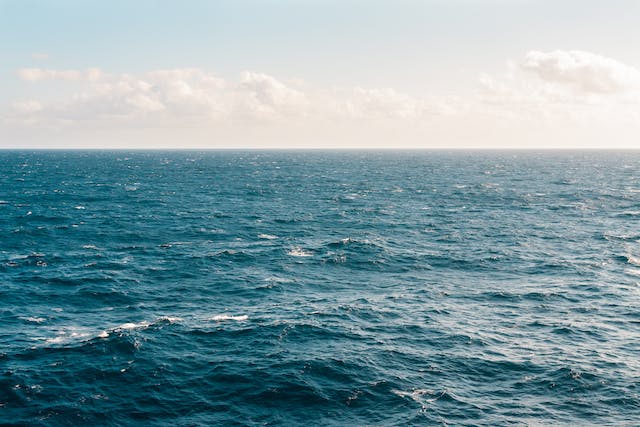
What color is the sea? It is technically blue, but that depends on the depth and what particles are in the water.
The sky is blue because the blue light wavelengths are scattered by molecules in the air. This is not why the ocean is blue. Generally the sea is blue because water absorbs red light and doesn’t absorb blue light, which is reflected back. The color of an object is down to the light that reflects off it and goes into our eyes. Something that reflects all light is white. Something that reflects no light is black. Something that reflects blue light, but absorbs other colors, is blue. Water molecules absorb red light and reflect blue light.
Light travelling through space is composed of photons which carry a lot of energy. These photons move in waves and they have a specific wavelength and a specific frequency. The more energy the photons have, the shorter the wavelength and the higher the frequency. Gamma rays have the most energy, the shortest wavelengths and the highest frequencies. Radio waves have the lowest energy, the longest wavelengths and the lowest frequencies. Visible light, the bit that we can see, comes somewhere in the middle. When this energy hits atoms, some of it goes through, some of it is absorbed, and some of it is reflected.
Atoms consist of a nucleus, electrons, and protons. The protons are inside the nucleus the electrons orbit around the nucleus. All of the electrons around a nucleus have a certain amount of energy that makes them vibrate. That is the perfect amount of energy for them. The electrons around different elements have different amounts of energy. If light hits these electrons, the kinetic energy the light photons are carrying is imparted to the electrons. More energy makes them vibrate more and they can jump to a higher orbit around the nucleus. However, they don’t like having more energy and they try to lose it as quickly as possible, either as heat or as light. When they lose it, they drop back down to their natural orbit. An electron can only absorb the exact amount of energy that will make it jump to the next orbital plane, and this is different for every element. If there is not enough energy, the light photon will pass by, and if there is too much energy, it will be reflected.
So, why is the sea blue? The electrons around the oxygen and the hydrogen atoms that make up the water molecule can jump to their next orbital plane if they are hit by the energy that is contained in the lower energy end of the visual spectrum, which are the red colors. The higher energy, blue end of the visual spectrum is reflected back. If we look at the sea, this higher energy light enters our eyes, and we perceive it as blue. As we go deeper into the sea, the yellows and orange wavelengths start to get stripped away by other particles that are suspended in the oceans. Then, by the time we get down to about 1000 m, even the blue wavelengths have been scattered away or absorbed by other particles and there is no more light. Sea creatures that live below these depths live without light. They use different methods to “see”, or they rely on other senses.
The sea can be different colors depending on what particles are suspended in it. Some tropical islands are famed for their crystal clear waters. Most of the ocean is a dark blue because of the organisms and sediment that is suspended in it. On most beaches, the warm surface water moves out to sea and colder water is pulled in from deeper down. This is called upwelling. The colder water comes from deeper down and has more sediment and organisms in it, making the sea darker. When an ocean is crystal clear, there is usually a coral reef that blocks the colder water from coming in, leaving the clear water and we only have the blue color caused by the water molecules. Sometimes the sea can appear green. This is caused by algae, or other organisms that are suspended in the water. These organisms absorb energy below the level of green light and reflect green light and anything with more energy. This is because they are plants and they make their energy from photosynthesis. Other particles or organisms suspended in the sea can change its color as well. And this is what I learned today.
Photo by Kellie Churchman: https://www.pexels.com/photo/landscape-photograph-of-body-of-water-1001682/
Sources
https://www.wtamu.edu/~cbaird/sq/2015/01/12/why-is-light-pure-energy/
https://www.pantone.com/articles/color-fundamentals/how-do-we-see-color
https://www.loc.gov/everyday-mysteries/physics/item/why-is-the-ocean-blue/
https://nerdfighteria.info/v/XA3rNgyEmwA/
https://science.nasa.gov/ems/03_behaviors/
https://www.physicsforums.com/threads/reflection-of-a-photon-by-an-atom.975011/#google_vignette
https://www.fnal.gov/pub/science/inquiring/questions/colorofatoms.html
https://www.nouvir.com/how-photons-meet-atoms.htm
https://dept.harpercollege.edu/chemistry/chm/100/dgodambe/thedisk/spec/5back4.htm
https://oceancolor.gsfc.nasa.gov/outreach/ocsciencefocus/BlueBluerBluestOcean.pdf
https://bigthink.com/starts-with-a-bang/why-sky-ocean-blue/
https://oceanservice.noaa.gov/facts/upwelling.html
